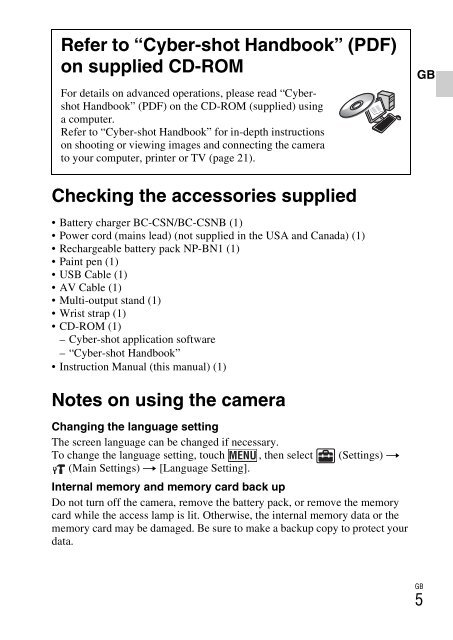Sony DSC-TX9 - DSC-TX9 Istruzioni per l'uso Italiano
Sony DSC-TX9 - DSC-TX9 Istruzioni per l'uso Italiano
Sony DSC-TX9 - DSC-TX9 Istruzioni per l'uso Italiano
Create successful ePaper yourself
Turn your PDF publications into a flip-book with our unique Google optimized e-Paper software.
Functions built into this camera<br />
• This manual describes each of the functions of TransferJet-compatible/<br />
incompatible devices, 1080 60i-compatible devices and 1080 50i-compatible<br />
devices.<br />
To check if your camera supports the TransferJet function, and whether it is<br />
a 1080 60i-compatible device or 1080 50i-compatible device, check for the<br />
following marks on the bottom of the camera.<br />
TransferJet-compatible device: (TransferJet)<br />
1080 60i-compatible device: 60i<br />
1080 50i-compatible device: 50i<br />
• Do not watch 3D images shot with this camera for extended <strong>per</strong>iods of time<br />
on 3D-compatible monitors.<br />
• When you view 3D images shot with this camera on a 3D-compatible<br />
monitors, you may ex<strong>per</strong>ience discomfort in the form of eye strain, fatigue,<br />
or nausea. To prevent these symptoms, we recommend that you take regular<br />
breaks. However, you need to determine for yourself the length and<br />
frequency of breaks you require, as they vary according to the individual. If<br />
you ex<strong>per</strong>ience any type of discomfort, stop viewing the 3D images until you<br />
feel better, and consult a physician as necessary. Also refer to the o<strong>per</strong>ating<br />
instructions supplied with the device or software you have connected or are<br />
using with this camera. Note that a child’s eyesight is still at the development<br />
stage (particularly children below the age of 6). Consult a pediatrician or<br />
ophthalmologist before letting your child view 3D images, and make sure he/<br />
she observes the above precautions when viewing such images.<br />
On database files<br />
When you insert a memory card without a database file into the camera and<br />
turn on the power, part of the memory card capacity is used to automatically<br />
create a database file. It may take some time until you can <strong>per</strong>form the next<br />
o<strong>per</strong>ation.<br />
GB<br />
6<br />
Notes on recording/playback<br />
• To ensure stable o<strong>per</strong>ations of the memory card, we recommend that you use<br />
this camera to format any memory card being used with this camera for the<br />
first time. Note that formatting will erase all data recorded on the memory<br />
card. This data cannot be restored. Be sure to backup any important data to a<br />
PC or other storage location.<br />
• If you repeatedly record/delete images, fragmentation of data may occur on<br />
the memory card. Movies may not be able to be saved or recorded. In such a<br />
case, save your images to a PC or other storage location, then [Format].<br />
• Before you start recording, make a trial recording to make sure that the<br />
camera is working correctly.<br />
• The camera is neither dust-proof, nor splash-proof, nor water-proof.<br />
• Avoid exposing the camera to water. If water enters inside the camera, a<br />
malfunction may occur. In some cases, the camera cannot be repaired.
















